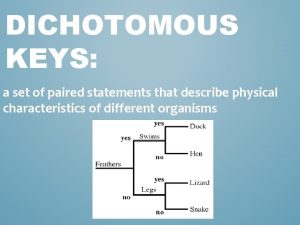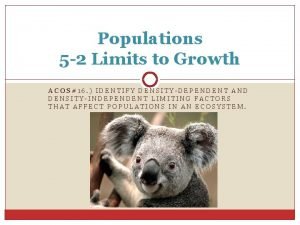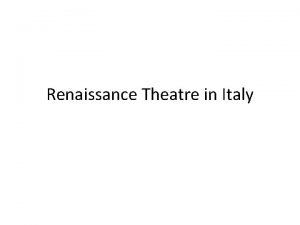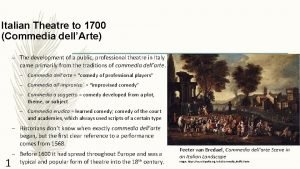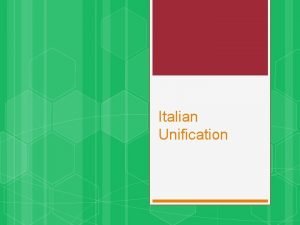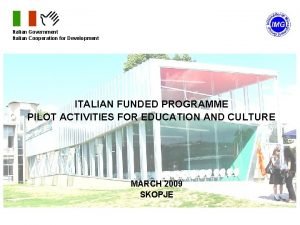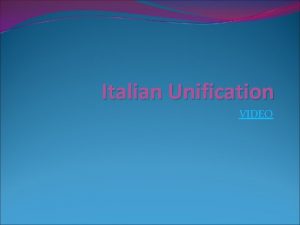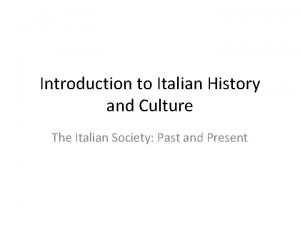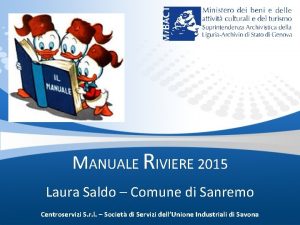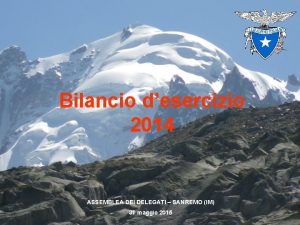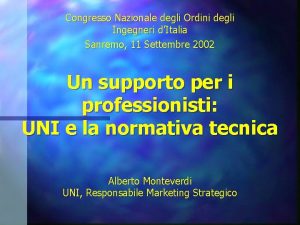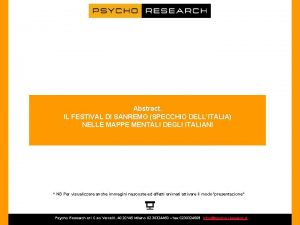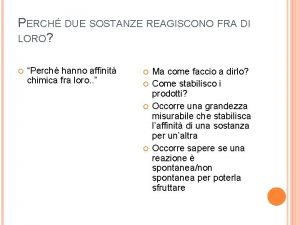Perch Sanremo Sanremo Teaching Italian Social History through

















- Slides: 17

‘Perché Sanremo è Sanremo’: Teaching Italian Social History through Popular Music Cecilia Brioni Italian Teachers Day – 02/03/2019 Francis Holland School in London

Sanremo 2019 • Mahmood, ‘Soldi’

Presentation outline • Why Sanremo? • Focusing on popular music: stars and music genres • The history of Sanremo: between tradition and innovation • Case studies: Young singers at Sanremo

Perché Sanremo è Sanremo? • Sanremo and Italianità: popular music ‘stands for, symbolizes and offers the immediate experience of collective identity’ (Frith 1996) • Sanremo and ‘canzone italiana’ • Sanremo and performers

Sanremo and music genres • What is ‘la canzone italiana’? • ‘Canzone italiana’ as invented tradition (Tomatis 2019) • Communality of themes: love, the nation, nostalgia • Music genres at Sanremo: transnational influences • Foreign singers in 1960 s editions: soul, blues, jazz • More recently: electronic music, hip hop, rock, indie

Stardom and Sanremo • Singers embody the ‘physicality of music’ (Lury 2001): performance, dance, gestures, interactions either reproduce or challenge notions of respectability • ‘The star phenomenon reproduces the overriding ideology of the person in contemporary society’ (Dyer 2004): stars mirror the complexity of Italian society, in terms of age, gender, ethnicity, class

The history of Sanremo: Between tradition and innovation ‘The history of Italian popular music was to gamble on an attempt to strike a balance between what had come to be regarded as the “tradition”, jealously guarded at Sanremo, and the spurts of renewal which were also circulating in Italy’ (Agostini 2007)

Innovation and youth ‘The relationship with the younger generation was a constant torment for Sanremo, caught, as it was, in a perpetual balancing act between its identity as a mainstream media event […] and the shoots of renewal, many emanating from its accommodation of the young public’ (Agostini 2007)

‘Nel blu dipinto di blu’ (1958) • Spreading out of arms, lyrics conveying freedom and carefree attitude: Miracolo economico • American-inspired rhythm, nasal and forced vocal style (crooners): Americanisation of Italian sociey

‘ 24, 000 Baci’ (1961) • Sexuality, Rock and roll, Dance • Celentano turns his back to the audience • Emergence of youth not conforming to societal values of 1960 s Italian society

‘Non ho l’età (per amarti)’ (1964) • Not all youth was subversive: Cinquetti sings of young women’s modesty, demure stage presence • Possibly a reaction to the emergence of youth as a separate social subject in Italy – domestication of youth

Melodia vs. Beat (1966) • ‘Capelloni’ (beat groups) entering the contest • Long hair for men, short hair for women: challenge to gender respectability in Italy • Protest songs and Luigi Tenco’s suicide (1967) • Youth as a political subject in Italian society

‘Vita spericolata’ (1983) vs ‘Noi, ragazzi di oggi’ (1985)

2000 s: Youth and talent shows • Revitalisation of the ‘canzone italiana’ thanks to talent shows: same themes, new rhythms • Plurality of genres entering the festival • Centrality of contemporary issues in song lyrics

Teaching Italian Social History through Popular Music • Popular music can complement the teaching of Italian culture and recent social history • Methodology: talking about music genres and music stars can help rethinking the concept of Italianità and the supposed immutability of Italian society and culture • Focusing on young performers sheds light on issues of preservation and/or modernisation in Italian society, and favours students’ participation

Cecilia. brioni@hull. ac. uk Thank you!

Bibliography • Agostini, R. (2007) ‘The Italian Canzone and the Sanremo Festival: change and continuity in Italian mainstream pop of the 1960 s’ in Popular Music, 26/03. 389 – 408. • Agostini, R. (2014) ‘Sanremo Effects: the Festival and the Italian canzone’ in Fabbri, F. & Plastino, G. (eds) (2014) Made in Italy: Studies in Popular Music. New York; London: Routledge. • Borgna, G. (1997) L’Italia di Sanremo: Cinquant’anni di canzoni, cinquant’anni della nostra storia. Milano: Mondadori. • Dyer, R. (2004) Heavenly Bodies: Film, Stars and Society. 2 nd edition. London; New York: Routledge. • Frith, S. (1996) Music and Identity. In Hall. , S. & Du Gay, P. (eds) Questions of Cultural Identity. London; Thousand Oaks, New Delhi: SAGE Publications, 108 -127. • Lury, K. (2001) British Youth Television: Cinicism and Enchantment. Oxford: Clarendon Press. • Tomatis, J. (2019) Storia culturale della canzone italiana. Milano: Il Saggiatore.
 Croff bologna
Croff bologna Internal anatomy of a perch
Internal anatomy of a perch Perch testes
Perch testes Perch phylum
Perch phylum Monkey dichotomous key
Monkey dichotomous key Perch nmr software
Perch nmr software Perch dissection
Perch dissection Virtual perch dissection
Virtual perch dissection Perch la fenolftaleina stata aggiunta allacido
Perch la fenolftaleina stata aggiunta allacido Density independent factors examples
Density independent factors examples Amish inbreeding
Amish inbreeding Italian renaissance theater
Italian renaissance theater Brief italian history
Brief italian history Italian theatre history
Italian theatre history Important dates in italian history
Important dates in italian history Italian sports club werribee
Italian sports club werribee Purposes of micro teaching
Purposes of micro teaching Social thinking and social influence in psychology
Social thinking and social influence in psychology




